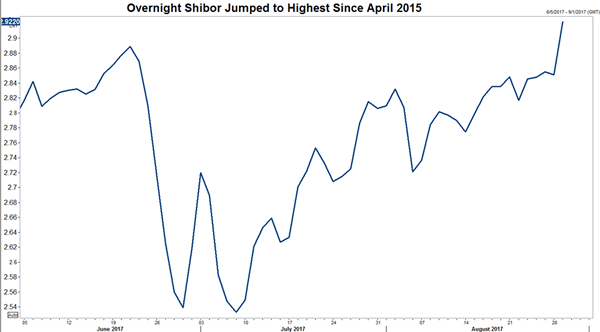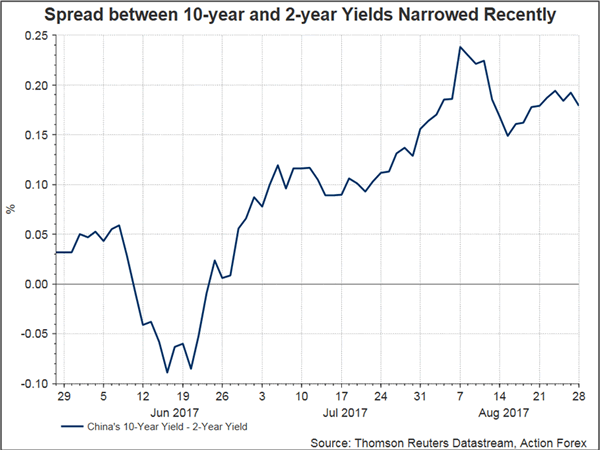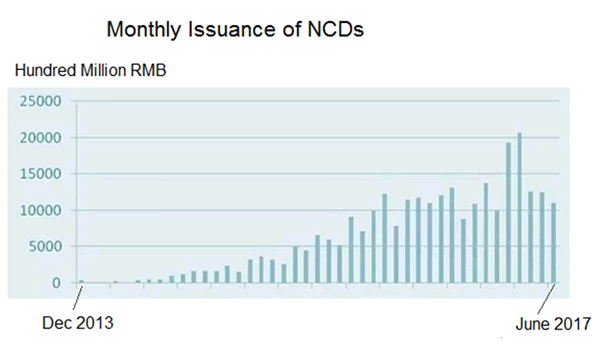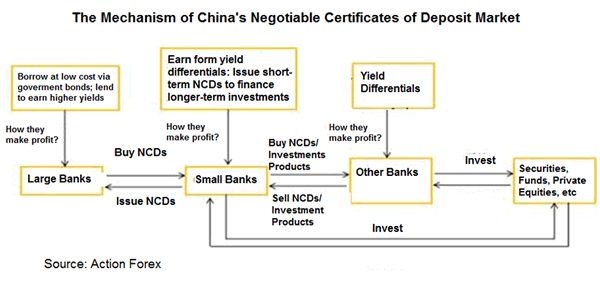The two key phenomena, tightening in liquidity condition and renminbi strength, in the Chinese market have persisted. Last week, PBOC auctioned RMB 80B of 3-month Treasury deposits at 4.51%, the highest since December 2014. This came in after another auction of 3-month Treasury deposits on August 18, at 4.46%. Higher interest rates signaled that the government is trying to increase the borrowing cost, tightening money supply. Indeed, liquidity conditions have remained tight in China, with both interbank rates and bond yields higher. Renminbi firmed, thanks to the broad-based weakness in the greenback and the Chinese government’s capital control measures. USDCNY fixing has fallen to 6.6293, lowest level since August 2016, on Tuesday. The current liquidity environment and renminbi strength are in line with PBOC’s "prudent and neutral" monetary policy stance, with the main goal of "deleveraging".
1. The Trend of Tighter Liquidity Conditions Continues
Overnight SHIBOR jumped to 2.92% on Tuesday, a level not seen since April 2015. This also marked a +7.1 bps increase from the prior day and +10.5 bps from the same period last year. Indeed, overnight SHIBOR has increased 175 bps in the first three weeks of August. The tightened liquidity condition has pushed bond yields higher. 5-year yields eased modestly to 3.65%, after soaring to a 2.5-month high of 3.652% on Monday, while 10-year yields also stayed high at 3.694%, after a rise to 3.702%, highest since May 11, 2017, on Monday. Note also that the spread between 10-year and 2-year government bond yields has narrowed recently. PBOC refrained from injecting liquidity to the market, draining a net RMB 330B, last week. We expect the liquidity would remain tight, if not tighter, in the coming month, as a record RMB 2.3 trillion in maturities of negotiable certificates of deposit (NCDs).


Negotiable Certificates of Deposit (NCDs)
One of the key areas of the government’s deleveraging work is to curb NCDs which have mushroomed as a result of the accommodative monetary policies after the global financial crisis. The value of outstanding NCDs expanded to RMB 8.43 trillion as of July. NCDs contribute to 13% of total bond market in China this year, up from 1.7% in 2014.

Regulatory loopholes have made NCDs a popular way of financing for small banks (banks outside of top 10 by market value accounted for 76% of total sales) in China. The unruly manipulation of NCDs as a means of financing has resulted in a serious problem of asset liability maturity mismatches that the government seeks to tackle now.
The flowchart below illustrates the mechanism of NCDs. Small banks are keen on issuing short-term NCDs to large banks which are able to acquire funds at low cost in an environment of accommodative monetary policy. Upon acquiring the funding through NCDs, small banks then invest by purchasing NCDs issued by other banks and invest in wealth management products (funds, private equities, stocks, etc) which are usually longer-term investments. The problem of asset liability maturity mismatches appears here: the small banks make profits by issuing shorter-term NCDs and investing in longer-term instruments. However, they would fail to repay its debts to the large banks as they are bound by the longer-term investments. This has created a vicious cycle as the small banks have to keep issuing new NCDs for refinancing or they would have to sell their investments.

Although financial institutions are required to cap interbank liability at 33% of total liability, NCDs are not included although it has the same function as interbank liability. Therefore, NCDs have been virtually unregulated until recently. At the second quarter monetary policy report, PBOC pledged that NCD would be included in the interbank liability indicator in the macro-prudential assessment (MPA) from 1Q18 – treating NCDs as interbank liability.
As illustrated above, the root cause of NCDs is the easy money acquired by large banks. We expect the central bank to continue to maintain a relative high interest rate environment so as to increase the cost of issuing NCDs.
2. China Favors Renminbi Strength
Another phenomenon is the strength of renminbi, thanks to the broad-based weakness in the greenback and the Chinese government’s capital control measures. USDCNY fixing has fallen to 6.6293, lowest level since August 2016, on August 29. We believe the government is in favor of a stronger renminbi, not only because it helps tightens the monetary policy, but also because it attracts foreign capital inflow.
Indeed, the government has continued its capital control measures so as maintain a relatively firm renminbi. The National Development and Reform Commission (NDRC) on August 18 issued new rules on foreign investments, introducing three categories, namely banned, restricted and encouraged of investments. According to NDRC, banned industries include those in the military, gambling and sex industries; restricted industries include those in real estate and hotels, film and entertainment, sports, and those that do not comply with environmental standards; and encouraged industries include those that promote the Belt and Road, improve China’s technology or research and development, and those that expand oil, mining, agriculture and fishing. This marks another layer of restrictions over capital outflow.
We will be receiving the August FX reserve next week. We expect FX reserve to remain strong for another month. Given the weak USD, it is less necessary for PBOC to sell foreign currencies to support renminbi.













